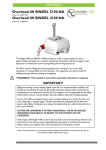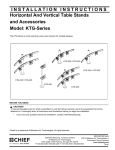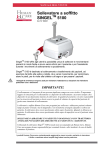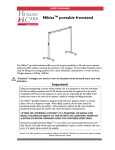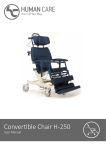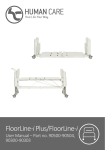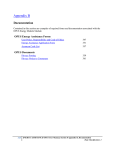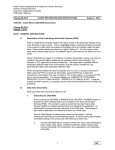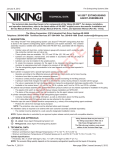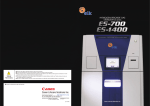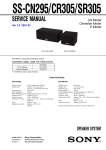Download User Manual - Elan Medical Supplies
Transcript
USER MANUAL Overhead lift SINGEL 5100 NA Art. No.: 50001-NA Overhead lift SINGEL 4100 NA Art. No.: 41000-NA Overhead lift SINGEL 5100 NA Herkules Art. No. 50500-NA The Singel 5100, SINGEL 4100 and SINGEL 5100 Herkules provide you with a unique ability to move a patient safely and easily, as a result of which both the patient and the caregiver avoid exposure to unnecessary strain during lifting and moving operations. The lift is used for lifting and moving a patient, for example to or from a bed, wheelchair or shower/bath or from the floor. The apparatus can also be used for walking training, balance training and weighing. “WARNING!” This symbol is used when particular attention is required IMPORTANT! Lifting and moving a person always entails some risk. You should therefore read through the instructions carefully for both the lift and lift accessories. Always make certain that the accessories you are using work with the lift. As a caregiver, you are responsible for the safety of the patient and you must be familiar with their ability to cope with the lifting situation. Human Care’s lifts are designed only to raise and lower patients in a vertical direction, and never diagonally or through angles. The lift must always be positioned directly above the patient when lifting. The patient must always be positioned above the surface onto which they are to be lowered. LIFTING OR LOWERING A PATIENT DIAGONALLY OR IN AN ANGLED MOVEMENT MAY RESULT IN INJURY TO THE PATIENT OR THE CAREGIVER. If the Singel 5100/Singel 4100/Singel 5100 Herkules is used in any way that is not recommended by Human Care, then Human Care will not accept responsibility for any injuries or accidents that may occur. Always contact your supplier if you have any questions or if anything is unclear. Human Care’s products are continuously being developed and updated and we reserve the right to make design changes without prior notice. Contents Safety instructions ........................................................................................................ 2 Technical specification Singel 5100 ................................................................................. 3 Technical specification Singel 4100 ................................................................................. 3 Technical specification Singel 5100 Herkules ................................................................... 4 Product description ...................................................................................................... 4 Intended use ................................................................................................................ 5 Product label................................................................................................................ 5 Symbols on the unit ...................................................................................................... 5 Functions ..................................................................................................................... 6 Charger ....................................................................................................................... 8 Belt tension guard ........................................................................................................ 9 Using the lift ................................................................................................................ 9 Telescopic bar ............................................................................................................ 10 Definitions ................................................................................................................. 11 Troubleshooting ......................................................................................................... 12 Care instructions for the lift and accessories................................................................. 13 Slings and accessories ................................................................................................. 14 1 Safety instructions Before using for the first time, make sure that: you have read and understood this user manual for the lift and all of its accessories the lift has been installed in accordance with the installation instructions the lift accessories are intended for use with the lift and are correctly fitted the lift’s batteries have been charged for at least six hours 1. Check to see if there is a distance strap suspended from the rail or if there is a hook fitted to the rail roller. The recommended minimum height from the floor to the distance strap is 1,850 mm. 2. Remove the lift (1), the charger (2) and the remote control (3) from the packaging. 3. Remove the seal from the lifting belt (6) after first reading the instructions. 4. Connect (16) the remote control (3) to the lift (1). 5. Plug the charger (2) in at an easily accessible wall socket. 6 6. Plug the remote control (3) into the charger (2). If the indicator light is glowing yellow, charge until the 1 indicator light turns green. 3 The lift is designed exclusively for lifting people, and only one at a time. 10 Before use, always ensure that: 16 personnel who use the equipment have been given adequate tuition and training in use of the lift and its accessories the lifting belt is not twisted or worn and that it can move freely in and out of the lift there are no evident signs of wear and tear or other damage to the lifting accessories the correct types, sizes, materials and designs of the accessories have been selected with respect to the patient’s safety and needs the lift accessories have been correctly installed. The sling’s strap loops must be checked once the loops are fully extended when lifting but before the patient is lifted from the underlying surface Human Care provides suitable training in safe operation of the lift and other accessories. Further information about slings, rail systems and other accessories can be found on www.humancare.se Important! To ensure that the lift belt will not be damaged, it is important that the lift is balanced during moving, lifting and lowering operations. Never hold or pull the lift belt when moving a patient. It is also important that the lift belt is tensioned as it is wound in. Warning! Modification of the product is not permitted without the manufacturer’s consent! 2 Technical specification Singel 5100 Lifting capacity, max.: Dimensions: (WxHxL) Emergency lowering: Type and class: Class: 220 kg/484 lbs/34.6 st. Start/stop: soft 450x180x340 mm Lift weight: 10 kg/22 lbs/1.6 st. 17.7x7.1x13.4 in Batteries: 2x12V 3.2Ah electronic/manual Indicator: B Stand by flashing GREEN Internally powered Active constant GREEN equipment Charge flashing RED Lift IP class: IPX4 Error constant RED Remote control Class IP65 Lifting height: 1,680 mm Noise level: 50 dBA unloaded/65 dBA loaded Lifting speed: 1.8 m/min 3.0 m/min (unloaded only) Battery charger: Input 100-240V AC 50-60 Hz, 1.6 A; Output 27.8V, 0.8A DC Battery charger IP class: IPX0 ETL: Yes This product is designed for repeated use The telescopic bar is adjustable to three different widths: 35, 45 and 55 cm. (13.8/17.2/21.7 in.) Technical specification Singel 4100 Lifting capacity, max.: Dimensions: (WxHxL) Emergency lowering: Type and class: Class: 150 kg/330 lbs/23.6 st. Start/stop: soft 450x180x340 mm Lift weight: 10 kg/22 lbs/1.6 st. 17.7x7.1x13.4 in Batteries: 2x12V 3.2Ah electronic/manual Indicator: B Stand by flashing GREEN Internally powered Active constant GREEN equipment Charge flashing RED Lift IP class: IPX4 Error constant RED Remote control Class IP65 Lifting height: 1,680 mm Noise level: 50 dBA unloaded/65 dBA loaded Lifting speed: 1.8 m/min 3.0 m/min (unloaded only) Battery charger: Input 100-240V AC 50-60 Hz, 1.6 A; Output 27.8V, 0.8A DC Battery charger IP class: IPX0 ETL: Yes This product is designed for repeated use The telescopic bar is adjustable to three different widths: 35, 45 and 55 cm. (13.8/17.2/21.7 in.) 3 Technical specification Singel 5100 Herkules Lifting capacity, max.: Dimensions: (WxHxL) Emergency lowering: Type and class: Class: 300 kg/661 lbs/47.2 st. Start/stop: soft 450x180x340 mm Lift weight: 10 kg/22 lbs/1.6 st. 17.7x7.1x13.4 in Batteries: 2x12V 3.2Ah electronic/manual Indicator: B Stand by flashing GREEN Internally powered Active constant GREEN equipment Charge flashing RED Lift IP class: IPX4 Error constant RED Remote control Class IP65 Lifting height: 1,380 mm Noise level: 55.6 dBA unloaded/45.4 dBA loaded Lifting speed: 1.8 m/min 3.0 m/min (unloaded only) Battery charger: Input 100-240V AC 50-60 Hz, 1.6 A; Output 27.8V, 0.8A DC Battery charger IP class: IPX0 ETL: Yes This product is designed for repeated use The telescopic bar is adjustable to three different widths: 35, 45 and 55 cm. (13.8/17.2/21.7 in.) Product description 1. 2. 3. 4. 5. 6. 7. 8. 9. 10. 11. 12. 13. 14. 15. 16. 17. Overhead lift Singel 5100/Singel 4100/Singel 5100 Herkules 6 Charger Remote control UP button (remote control) 1 DOWN button (remote control) Lift belt Leg hook Telescopic bar Bar hook Switch with protective cover UP button (lift up) DOWN button (lift down) 14 Emergency lowering button Indicator light Emergency stop Remote control connection Charger mains power lead 12 2 11 4 5 4 3 10 7 2 17 13 16 15 8 9 9 4 Intended use The overhead lift has been designed and tested for use indoors and is classified as an IPX4 product. The climatic conditions should be as follows: ambient temperature from 0°C to 50°C, relative ambient humidity from 30% to 80% and ambient pressure from 790 hPa to 1,060 hPa. Product label The product label contains information about the lift. This label is located on the front of the lift. 1. Date of manufacture 2. Serial number 1 The Singel 5100, Singel 4100 and the Singel 5100 Herkules have been tested by an accredited test institute and comply with the necessary requirements in accordance with the Medical Devices Directive for Class 1 products. 2 The device is CE labelled and has been tested in accordance with the requirements in the Swedish Act on Medical Devices and the standards ISO EN 10535, ISO EN 60601-1 (Electrical Safety) and ISO EN 60601-1-2 (EMC). Wireless transmission equipment, mobile telephones etc. must not be used close to the device as it may affect its function. Particular caution must be observed when using strong sources of interference such as diathermy and such like, to ensure that no diathermy cables are placed on or near the device. If in doubt, ask the person in charge of the equipment or the supplier. Symbols on the unit f g h j k l n o q p CE labelling Date of manufacture Manufacturer Max. load Read the instructions and make sure you understand them before using this product Article number/reference number Serial number Warning The lift contains lead batteries and electronics and it must be recycled appropriately 0/1 Type-B product Switch off the product/Switch on the product r Third party certification labelling (not applicable for all regions and versions) 5 Functions Emergency stop In an emergency, the emergency stop can be activated by pressing the RED button (15) To reset the emergency stop, turn the RED button clockwise. Emergency lowering: In case of an emergency situation, the emergency lowering button (13) can be pressed. An audio signal indicates that the lift is lowering. Always ensure that emergency lowering can be performed as safely as possible for the patient. The emergency lowering button only works when the mains switch (10) is switched on and emergency stop has been de-activated. 15 10 13 NB: The emergency lowering button must only be used in emergency situations. If the mains switch (10) is turned to OFF and there is a person in the sling, the lift will sink safely and slowly (manual emergency lowering). Safety catch The lift is equipped with a safety catch. This prevents involuntary falls. If the lift belt is pulled out too quickly, the safety catch will engage, thus preventing the fall. Slacken the lift belt to unlock the catch. Overheating protection The lift has overheating protection, which stops the motor if it gets too hot. Overheating can occur if the motor is overloaded or operated continuously for quite a long time. The lift’s work cycle (work:pause) is 15:85. Maximum continuous operation is six minutes. If this is exceeded, there is a risk of the motor overheating. 6 Suspending the lift from the rail Place the lift on a suitable surface. Turn on the mains switch, press the DOWN button (5, 11) and pull out a suitable length of lift belt and hook it onto the distance strap diagonally from above (see fig. A). The lift is now ready for use. 6 11 Fig. A Remote control functions The remote control (3) has an UP button (4) and a DOWN button (5). When the lift is loaded with less than approx. 40 kg, it can be run in two speeds. Pressing the buttons lightly makes the lift run at slow speed, while pressing hard makes it run at high speed. The force required to operate the pushbuttons is 4.4N. If the lift is loaded with more than approx. 40 kg, the lift will only run in the slower mode. 7 Charger The indicator on the lift flashes red when the batteries need recharging. Plug the charger cable into the remote control (3) to start charging. The list can only be used with a charger recommended by Human Care, article number 50880. Charge regularly, preferably every night. The charger must be disconnected when using the lift The unit is charged regardless of the position of the main switch. If the lift is equipped with an emergency stop button, check that is not pushed in during charging See separate manual for the charger. Indicator lamp The indicator lamp (14) has four indicating modes and it only works when the mains switch (10) is on. Flashing green – The lift is on and ready for use. Constant green – The lift is in operation or loaded. Flashing red – The lift needs to be charged. Constant red – The lift is blocked. This happens during charging and if there is an error signal (see troubleshooting table). 10 14 8 Belt tension guard The lift is equipped with a belt tension guard that prevents unintentional discharging of the lift belt. The lift must be loaded in order to be able to pull the belt out. This means that when the lift is lowered to a surface, the lift belt must be pulled out while pressing the DOWN button. The purpose of this is to pull out the necessary length of the lift belt in order to be able to hook it onto the rail hook, or to unhook it. Using the lift Press the UP button (4, 10) to lift the patient, and the DOWN button (5, 11) to lower the patient. Pressing the button activates a soft start, and releasing it causes a soft stop. 12 11 5 4 9 Telescopic bar Set the telescopic bar (8) to the prescribed position. Ensure that the hooks (9) are in the same position on both sides. Place the patient in the selected sling according to the sling instructions and hang the sling in the hooks (9) on the telescopic bar and in the leg hook (7). Check that the sling is properly anchored in the hooks (9, 7). The hanger bar hooks (9) have three adjustable positions. To change position, turn the hooks 1/4 turn while pushing or pulling the hooks to the desired position. The hooks will automatically fall into place in position, therefore it is necessary to repeat the turn (1/4 turn) when passing the middle position (position 2) (See fig. B). 9 9 7 Fig. B 10 Definitions (A) is the total height of the system The distance from the ceiling down to the bottom of the lift hanger A = 380-460 mm (depending on rail solution) (B) is the lifting height The difference between the lift’s highest and lowest positions i.e. lift belt length. A Distance straps are available as an accessory in different lengths, if you need to extend the length of the lift belt. W = 1,680 mm Singel 5100 and Singel 4100 W = 1,380 mm Singel 5100 Herkules Lift cycle B Singel 5100 and Singel 4100: Lift action consisting of lifting 420 mm and lowering 420 mm. Singel 5100 Herkules: Lift action consisting lifting 345 mm and lowering 345 mm. 11 Troubleshooting Description Nothing happens when the UP buttons (4 or 11) or DOWN buttons (5 or 12) are pressed. Indicator lamp (14) Not lit Nothing happens when the UP button (4) or the DOWN button (5) is pressed on the remote control (3) Nothing happens when the UP buttons (4 or 11) or DOWN buttons (5 or 12) are pressed. Flashing green. Flashing red. Nothing happens when the UP buttons (4, 11) are pressed. Nothing happens when the UP buttons (5, 12) are pressed. Nothing happens when the UP buttons (4 or 11) or DOWN buttons (5 or 12) are pressed. The indicator lamp (13) turns from green to flashing red. Flashing green Flashing red Constant red 14 1) Charging in progress. Interrupt charging. 2) Lift motor is overheated. Wait a while and try again. 3) The lift (1) is overloaded. Lower the lift using the emergency lowering button (15). The lift is in its maximum upper position. Press the DOWN button (5, 12) to lower it. The lift is in its maximum lower position. Press the UP button (4, 11) to raise it. The emergency stop (15) is pushed in. Activate by turning the red button clockwise. Flashing green Flashing red Flashing green Flashing red Flashing red 11 12 1 Action 1) Check that the mains switch (10) is ON. 2) The batteries are fully discharged. Charge the lift (1) immediately 3) The emergency stop (11) is pushed in. Activate by turning the red button clockwise. Check that the remote control (3) is connected to the lift (1). 5 4 The batteries need to be charged, but it is still possible to use the lift to lift the patient a few times, though the lift (1) should be charged as soon as possible. 15 10 13 12 Care instructions for the lift and accessories Care instructions for the lift The lift should be recharged every night. Dry the overhead lift using a slightly dampened drying cloth. Washing up liquid can be used. Never wash the overhead lift using water or any other fluids. NEVER use strong detergents on the lift unit. If the lift is to be disinfected, DuPontTM Virkon® can be used. The mains switch (10) should always be OFF during transport. Turn the mains switch (10) off or activate the emergency stop if the overhead lift is not going to be used for a few days. Otherwise the batteries will run down. Annual inspection The lift must be inspected at least once a year by personnel authorised by Human Care. Pay particular attention to parts that show wear. Installation, service and maintenance must be performed by personnel authorised by Human Care and using original spare parts. Daily inspection Always check the sling before use. There must be no loose seams or other signs of wear to lift belts, belts and fabric. If there are, replace the sling. Check the overhead lift for visible signs of damage. Monthly inspection Check the lift belt (6) for damage or wear and tear. Feed out enough of the lift belt to allow its entire length to be checked. Contact a retailer if the belt is damaged. Service agreements Human Care invites you to sign a service agreement for annual inspection and test loading. Transport and storage During transport, or when the lift is not going to be used for some time, the main switch must be off or the emergency stop button pushed in, otherwise the batteries will discharge. The climatic conditions should be as follows: ambient temperature from 0°C to 50°C, relative ambient humidity from 30% to 80% and ambient pressure from 790 hPa to 1,060 hPa. Expected lifetime The lift is expected to function for 10,000 lifting cycles at maximum lifting capacity or for 10 years with correct service and maintenance. Recycling Worn-out overhead lifts can be returned to Human Care for recycling. NB: Contains batteries and electronics that contain lead and which must be recycled accordingly (WEEE 2002/96/EC). For additional information about accessories and technical documentation, please visit our website at www.humancare.se 13 Slings and accessories If the maximum weight for any of the accessories, e.g. slings, lift bars and any other accessories is NOT the same as for the lift, then the lowest max. weight given for any one product is the one that shall apply. Always check the label on the lift and lifting accessories or contact Human Care if you have any questions or if anything is unclear. Slings Human Care’s range of slings is wide and should meet the user’s various requirements and needs. See www.humancare.se for further information about which models and sizes are offered. 50348 Scales Patient scales that can be used in conjunction with any of the Human Care lifts. Max. weight 320 kg. 20124 Distance strap Several different lengths are available in order to adjust the lift height to a suitable level. 50268 Four-point suspension bar Can be used in conjunction with any of the Human Care lifts. 50700 Stretcher The most portable lightweight stretcher with a lifting capacity of 200 kg. This stretcher can be assembled by one (1) person without any tools 50600 Portable Freestand Niklas The Freestand is adjustable in both height and width. The height can be adjusted up to 2,450 mm without using any tools. This makes the Portable Freestand Niklas the most portable solution on the market. The Freestand is intended for use when lifting users from e.g. a bed to a wheelchair. The Portable Freestand Niklas can be assembled by one (1) person without using any tools! Max. capacity is 220 kg. 50346 Cart Portability of the lift can be further enhanced with our new cart. The cart is specially produced for our Roomer 5200 and Singel 5100 lifts, but it can also be used with earlier Human Care lift models. 14 99567-ENG Rev B (2013-04-11) • Årstaängsvägen 21C SE-117 43 Stockholm, Sweden • +46(0)8 - 510 132 00 • Fax +46(0)8 - 665 35 10 • • www.humancaregroup.com • 15
















